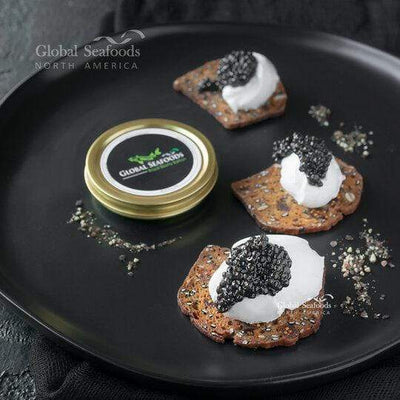How to Serve Beluga Caviar: Dos and Don'ts for a Perfect Presentation

How to Serve Beluga Caviar
Beluga caviar is one of the most prized delicacies in the world. Its rich, buttery flavor and delicate texture make it a favorite among connoisseurs. However, serving Beluga caviar can be tricky, as it requires a certain level of expertise. In this blog post, we will explore the dos and don'ts of serving Beluga caviar to help you impress your guests and make the most of this luxurious delicacy.
Dos
1. Store Caviar Properly
Beluga caviar should be kept refrigerated between 28–32°F (-2 to 0°C) in its original packaging until ready to serve. Do not freeze the caviar, as freezing can damage the delicate eggs and alter their flavor. To discover premium-quality Beluga caviar for your next gathering, check out this collection.
2. Use the Right Serving Dish
Always serve caviar on a non-metallic dish, such as glass or mother-of-pearl. Metal can react with the caviar and alter its taste. For an alternative to Beluga, explore the finest selections of Siberian Sturgeon Caviar.
3. Keep It Chilled
Beluga caviar should be served chilled on a bed of crushed ice. This helps maintain its flavor and texture throughout the serving.
4. Serve with the Right Accompaniments
Pair Beluga caviar with:
- Blinis
- Toast points
- Crackers
You can also add garnishes like chopped egg whites, egg yolks, and fresh chives. For those seeking more sustainable options, explore Wild Sturgeon Black Caviar.
5. Use a Mother-of-Pearl Spoon
When serving Beluga caviar, a mother-of-pearl spoon is essential to avoid altering the taste of the caviar. Wood or plastic utensils are acceptable alternatives. For other premium choices, consider the nutty flavors of Ossetra Sturgeon Caviar.
Don'ts
1. Don’t Overdo It
Beluga caviar is a delicate delicacy, and a little goes a long way. Serve it in small portions, about 1–2 ounces per person.
2. Don’t Mix Caviar with Strong Foods
Beluga caviar should be enjoyed on its own or with light accompaniments. Avoid overpowering flavors, as they can mask the natural nuances of the caviar. If you're exploring other luxury caviar types, consider Kaluga Caviar.
3. Avoid Serving with Champagne
Although traditionally paired with champagne, its acidity can overpower Beluga caviar’s delicate flavor. Instead, serve it with a crisp dry white wine or chilled vodka.
4. Never Use a Metal Spoon
Metal can react with caviar and compromise its flavor. Stick to non-metallic utensils for the best experience.
5. Don’t Serve It Too Cold
Serving caviar too cold can numb the taste buds, which detracts from the delicate flavor. Aim for a serving temperature of 40°F (4°C).
FAQs
1. Can I Freeze Beluga Caviar?
No, freezing Beluga caviar can damage its texture and flavor. Always store it in the refrigerator at the recommended temperature. For premium Beluga caviar, visit Global Seafoods.
2. Can I Use a Metal Spoon to Serve Caviar?
No, metal reacts with the caviar, altering its taste. Use a mother-of-pearl spoon instead.
3. What Should I Serve with Beluga Caviar?
Pair it with blinis, toast points, or crackers, and garnish with chopped egg whites, egg yolks, chives, or crème fraîche. Discover more luxury options like California White Sturgeon Caviar.
4. How Much Caviar Should I Serve Per Person?
Plan for 1–2 ounces per person to ensure everyone enjoys the delicacy without wasting this prized treat.
5. Is Champagne the Best Pairing for Beluga Caviar?
Not always. While traditional, champagne’s acidity can overpower caviar’s delicate flavor. Opt for chilled vodka or a crisp, dry white wine instead.
6. What Are Other Luxurious Caviar Options?
Explore a variety of options, such as White Sturgeon Caviar, Sevruga Sturgeon Caviar, and more from the Global Seafoods caviar collection.
Conclusion
Serving Beluga caviar is an art form, but by following these dos and don’ts, you can master the process and impress your guests. Proper storage, the right serving dishes, and complementary accompaniments are key to ensuring a memorable experience. Whether you’re enjoying Beluga caviar or experimenting with varieties like Paddlefish Caviar or Ossetra Sturgeon Caviar, these tips will enhance your caviar experience.
Explore More
- Paddlefish Caviar: A sustainable and affordable option.
- Wild Sturgeon Black Caviar: A luxurious, eco-friendly choice.
- Siberian Sturgeon Caviar: Perfect for any special occasion.
- Kaluga Caviar: A premium alternative to Beluga caviar.
For the ultimate caviar experience, browse the Global Seafoods Black Caviar Collection.
Also in News

How to Make Sea Bream Sushi With Dry-Aged Tuna & Crab Roll — Step-by-Step With Chef Joshua
A complete guide to making Sea Bream sushi at home, including filleting, curing, slicing, and building a Dry-Aged Tuna & Crab sushi roll. Chef Joshua shares professional tips for restaurant-quality results.

The Boiled Crab in Popular Culture: From Cajun Cuisine to Trendsetting Restaurant Phenomenon
From spicy Cajun-inspired seafood boils to hands-on dining experiences, The Boiled Crab has left a unique mark on popular culture. Discover its cultural roots and culinary influence.

Boiled Crab for Game Night: Everything You Need for a Perfect Seafood Party
Take your game night to the next level with a Boiled crab party. Learn the best recipes, cooking tips, and hosting hacks for a memorable seafood feast.

